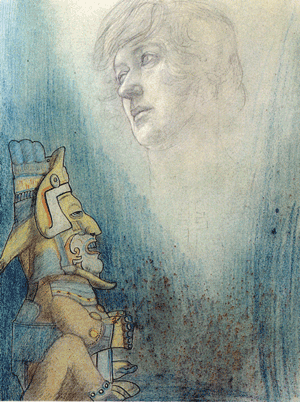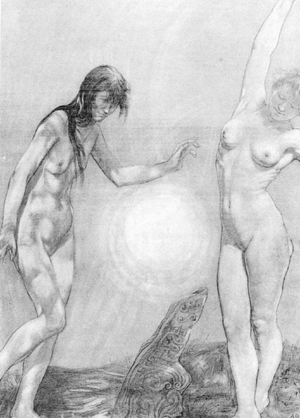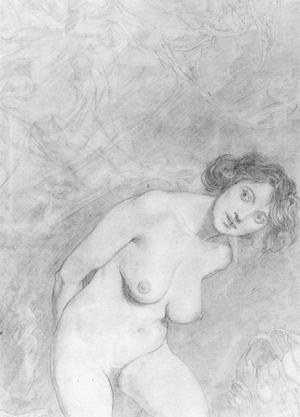Introduction to The Focus of Life by Francis Marsden (Frederick Carter)
| In the world of men are many orders: The most, those in whom multitudinous desires goad onward to some unimagined end — an end, vague, intangible, unreal — an end which, formulated and analysed, or accomplished, reveals itself as a down‑sitting in the satiety of grotesque comfort to impose a vacuous will upon youth — and of these of the deathly hand, no more. But of the explorers of the infinite and marvellous things of the inmost mind — that which is before thought was — few though they may be, more of consequence is to be known; they are the makers of images and seekers of God. These of the living hand, the makers of epics, the tellers of tales, fantastic, compelling, beyond belief, of that which is and never was, worshippers of a fair impossible she, tramplers of the slime of the pit, clamberers of the rock of the holy mountains, dreamers of the rose and the dew, of milken hill and vine of immortality, these are they that tell of the gay wisdom, of the true end of pleasure beyond becoming — who seek what is to be: They who sound the deep of the sacred name, the fourfold I AM, past, present, future, and in eternity. In the historical period which is still in some, if slight, degree within our knowledge, there remains to us for our true information little but the records left by these greater ones. That which they wrote, or carved, or which they handed down, nameless, for preservation in myth and fable, looms large in our lives or in our dreams, stirring to a passion of delight our child imaginations or moving profoundly our greybeard’s philosophical speculations. The work of these greater ones, dead and yet speaking, calls to some kindred condition in our own souls that cries out in recognition; a passionate rhythm of more intense life moves within us — and dies. As Plato wrote: “Writings are as memoranda, and as signposts for those that follow the same road.” The path is that way which one in ten thousand announces, and he is cried out upon as a madman or a knave by a world desiring to rest content with evanescent toys, slippery gains, light loves, and the ribald chaffering of the market places, or at moments of its most serious regard finding satisfaction in foolish phantasms of heavens painfully to be distinguished from the crass Utopias of sentimentality, and vended for self-interest by journals flush with reports of scandal and crime. Truly the deepest secret is always hidden even though it be laid in the public ways or cried from housetops. The search is to be known only to the seeker, it is not to be taught but only to be learned, and then hardly. All those who follow the strange gleam of that inmost light seem as those passers‑by in the Thousand and One Nights who, garbed as beggars and stained with travel, telling their marvellous histories proclaim themselves, “We are Kalendars, sons of Kings.” The stories of their strange experiences of wonder and despair suffice the nights of horror, and lift at last the shadow of the sword of the betrayed king as the voice recounts through the dark hours until the light. So in the great quest of the Grail through the ruined kingdoms of the Dark Ages by the knights, who also were the sons of kings, they of the Round Table; the knightly seeker who slept when he should have waked nor asked the needful question, was akin to the dire company who will not when they may; and like those who to‑day handle the secret things of the soul with strained alien comparisons demanding of the forlornest savages or of wretched neurotics the ultimate keys of the mysteries of the heart of man. The way proclaimed even by all the sages as by Plato and by Socrates, was that in which the bold knight Gawain failed, that which he had been warned to ask, he asked not. To that essential question “To whom is this cup served?” which he should have asked, the histories give no answer. Though the response implicit in the matter “He that wills, to him that asks” would have opened for him eyes which, without question and answer, drowsed through the holy vision. In the ancient churches, built for an agelong faith according to order, rule, and canon — proportion, ornament, all design and form was ordered according to tradition, a tradition alive and understood, capable of infinite variety, and yet in its essence simple, based upon a philosophy which maintained a coherent relation between imagination, art, and material life. This philosophic vision so often obscured is yet to be found again and yet again, for it expresses itself through the systematic order of proportions which regulate the expression of things immaterial in material, between life subjective and life objective. Thus were the measures of the Temple of the Most High, the pattern of the Soul. This tradition was handed down from previous generations,—at times of other manifestations of religious faith, yet on whom the light of joy and beauty had shone, — was passed from pagan to Christian, Chaldean and Egyptian, Hebrew, Greek, Indian and Mussulman, each and all took and gave and as always in human knowledge none knew all but each sacrificed the whole to the part. Their symbols differed as their outer garments but the inner desire, the purpose at root was ever the same, for however the races of man may differ in goods and observances, their moods and their mental and bodily functions are ever the same. Their symbols are diagrammatic images fixing the principles of the forms of protean shape changing thought, and giving guides and signs of power to the entity for the conquest of the inner world of darkling mood and passion, so in consequence each may be equated with its analogous symbol, and Eve as easily give a pomegranate as an apple — yet still be Eve. Within, the house of worship was divided by sacerdotal wisdom into two parts, an outer and an inner, and separated by a great screen for isolation of the hierarch from the simple devout. Images of the great forms of the god inspired founders, bearing symbols of their part in the mysterious origins of the faith, were arrayed upon it in a guardian company against the outer body of the church as if to protect the sacred place. A gate was set amidst them and beyond was the holy altar of the divine sacrifice. So the Gothic artists set all about their churches images of majesty or of grotesque to hold the gaze or menace the vulgar regard of inattention, and all was ordered and patterned, according to their vision of the mind. Ever between the one who desires knowledge, and that which, secret in itself, is to be known is arrayed the band of traditional powers past whom, by force of will, the source of their wisdom is to be gained. Beyond the Gate which they guard is the sacred feast of joy, there is the bread of strength and the draught of ecstasy: but these symbols are delivered into the hands of none but that one who has striven. None may offer sacrifice but one who has sacrificed greatly: to him that hath shall be given. As the sacred feast is the symbol of the great deliverance by death, therein is the culmination of the pattern of the life of man. The entry of the church by the narrow door, the traversing of the body of the church, the strait gate, the feast of the imagination beyond, is as the work of the artist whether manifested within or without, its climax is the venture of the soul in the search through a divine intoxication for the knowledge of things beyond the common sense. The true Temple, as we are taught, is the body of man: and the entrance to the innermost mystery of the ritual of thought and imagination is past the hierarchy of ancient powers that are at once of terror and of beauty. The way in, is that old obscure experiment of the philosophers, of which Thomas Vaughan writes “That death which the Kabalist calls Mors Osculi or the Death of the Kiss, of which I must not speak one syllable.” This mystical death is as the open entrance to the palace of Dreams where the Lady Despoina reigns, the sleep of vision which is as of the kiss of the dark King’s bride that unloosens the soul gently. The end of these gnomic divagations and appeals to philosopher and myth is this only, that they were all great according as they were great as imaginative artists, and as artists they were concerned with the world of images — of imagination — the vast abyss wherein by the divine faculty of dream, they became fishers and each in their degree drew out wonderful draughts, as strange even as those of the Arabian tales. This book is as a net containing a vessel of strange form, the contents are to be judged without undue prepossession, remembering that among strange symbols and images is the gate through which Truth is found. To your discriminating regard and full cogitation I deliver them, O reader. Francis Marsden. |
|
|||


